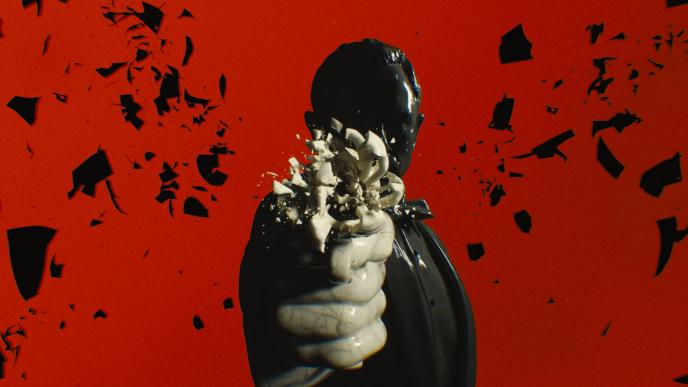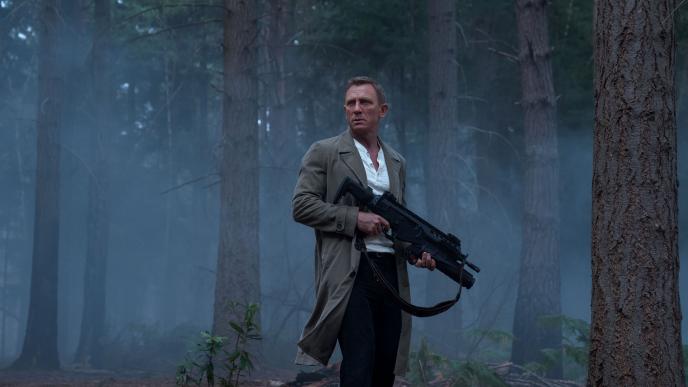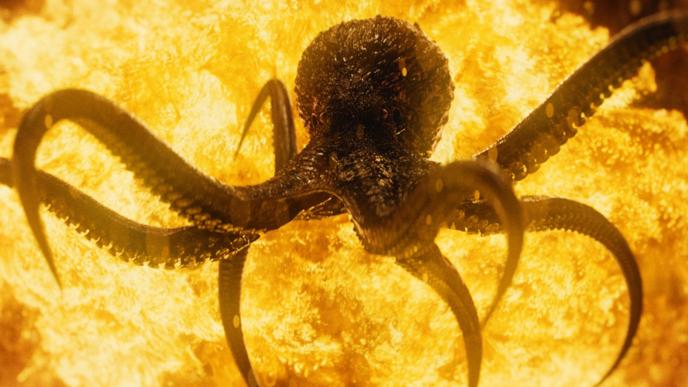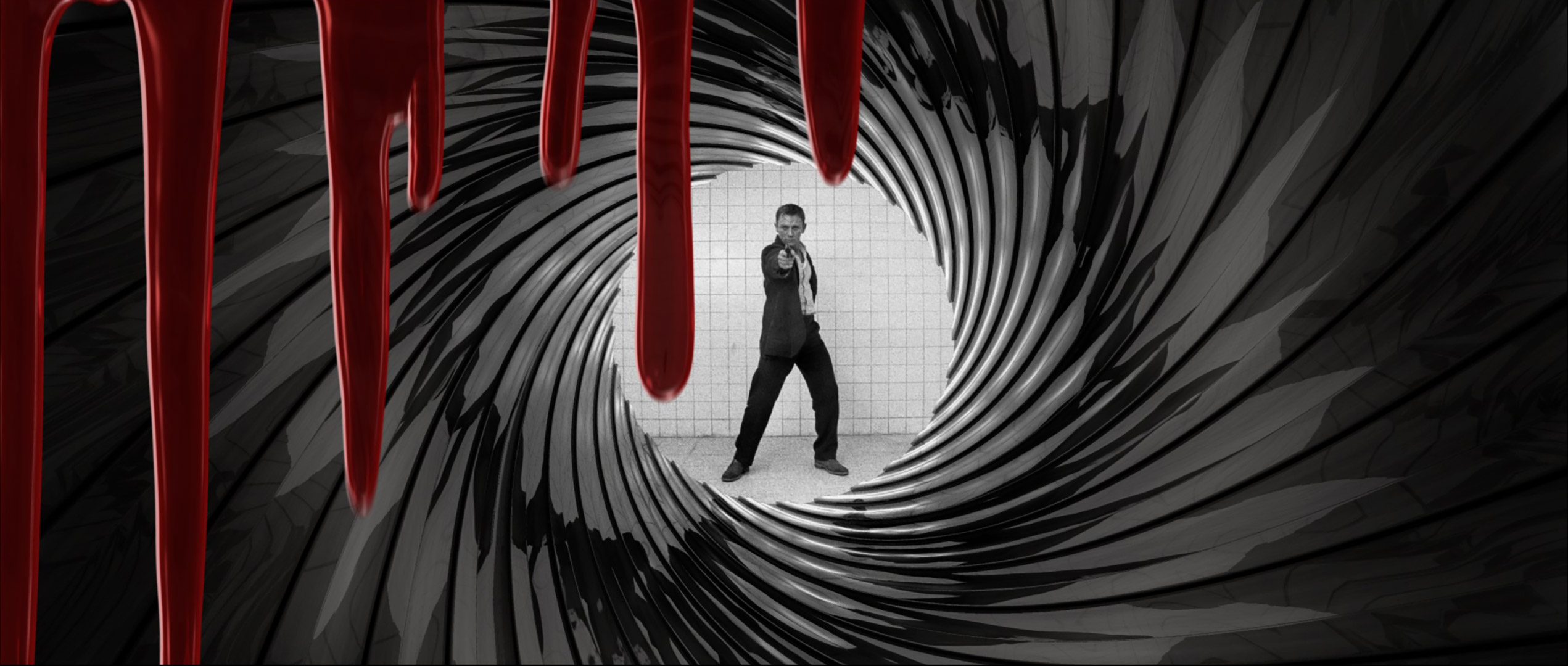
Bond Archive Collection
The name's Framestore. For many years, Framestore has been at the fore of title design across the James Bond movie franchise, working closely with the directors of the iconic sequences to deliver world-class visual effects and design. Find an in-depth look at the work behind Spectre here.
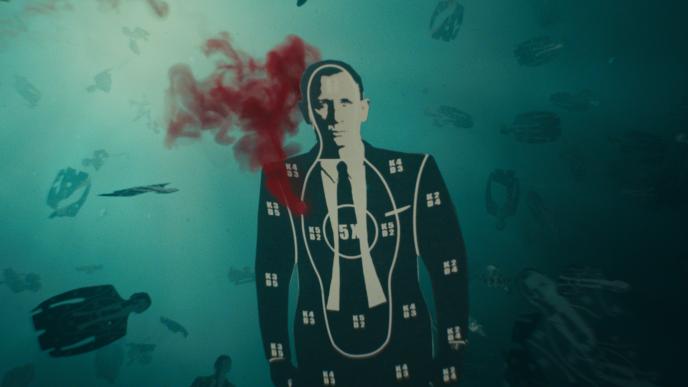
'Skyfall', 2012
Skyfall marked 50 years of James Bond on the big screen and, in this 007 collaboration between Daniel Kleinman and Framestore, we have a title sequence worthy of such an anniversary. Applauded at the premiere, the four-minute sequence opens underwater as Bond sinks lifelessly into the gloom, before Kleinman’s creative direction sends us on a spiralling journey into Bond’s subconscious.
Taking Kleinman’s first round of storyboards, a 3D pre-visualisation was created with Framestore partner company The Third Floor that refined the concepts and established the sense of continuous movement that Skyfall director Sam Mendes and Kleinman sought. Next came a live-action shoot at Pinewood Studios that included an underwater tank for that opening drowning shot, a day with Daniel Craig to shoot actions for the titles and the iconic ‘gun barrel sequence’, and another of girls and guns.
Framestore’s team was lead by William Bartlett as VFX Supervisor, who was joined by Diarmid Harrison-Murray (Head of 3D Commercials) and Russell Dodgson (Head of Nuke Commercials). The team developed sequences in parallel with regular input from the director. 'One of the challenges was to give the artists room to develop ideas, with the understanding that some might be dropped or changed as the job evolved', says Dodgson. 'The aim is for a cohesive sequence, that feels like it comes from one person’s mind. No one can be too precious about their own pixels!'
'This flexible way of working requires a different mindset but provides a great opportunity for creative ownershi', says Harrison-Murray. 'By assigning all the VFX work – from setup, animation through to lighting – across an entire scene to just one artist, that person is able to develop their scene as a whole, rather than just contributing one smaller element to it. It’s an incredibly satisfying way to work. One great example is Martin Aufinger’s beautiful and technically accomplished CG dragons.'
Nuke was a key tool for the job and was used in some way by every artist. One of the most important tasks to be carried out was creating the 3D cameras used to join the continuous forward camera movement. William Bartlett took charge:
'From experience, I have found that getting an overall sense of timing and movement is key to the job’s success', says Bartlett. 'As soon as we received an early version of Adele’s song we concentrated on finding visual ways to complement the ebb and flow of the music. To do this, scenes were blocked out in Nuke, incorporating the live action footage, cameras and basic geometry. These were exported to the 3D team for development and execution.'
Some of the biggest CG challenges were the full-3D volumetric environments, such as the heart, made up of hundreds of veins, that transforms into a skull. Not only was it a difficult task to procedurally animate and simulate all the veins, but the volumetric nature of the shots and the interactive lighting posed a huge rendering challenge to the team. Houdini was chosen due to its fantastic volumetric rendering capacities. Combined with our creative input, its physically based render engine really pushed the quality of the images.
Evolving right to the last minute, the piece closes with a dramatic sequence, which sees blood raining from the sky and bleeding gravestones crumble to the sound of Adele's powerful voice. A classic Bond moment. A piece that Framestore is proud to have been part of.
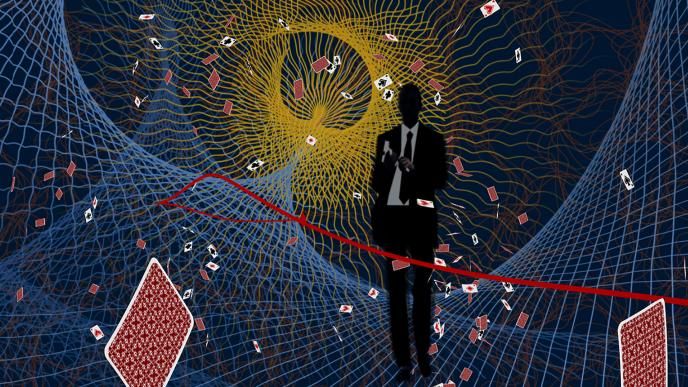
'Casino Royale', 2006
Casino Royale opened in the UK on 16 November and in the US on 17 November 2006. The James Bond adventure is directed by Martin Campbell and produced by Barbara Broccoli and Michael G. Wilson. Framestore not only collaborated on Casino Royale's stunning title sequence, working with director Daniel Kleinman, but also provided the film's full digital mastergrade.
License Relaunched
Casino Royale is the 21st Bond film to be produced under the auspices of Eon Productions, in a series that began in 1962 with Dr. No. The introduction of Daniel Craig as a new Bond was the perfect opportunity for a top to bottom spring clean of the franchise. 'Casino Royale is the first of the Bond novels – it came out in 1953', says title designer, Daniel Kleinman. 'And although this film is set in the present, it really takes Bond back to square one – to his action-agent roots. Going back to this source material signals the start of a new Bond era.'
'The titles have been a defining element of the Bond films for decades', continues Kleinman, 'And a defining feature of the titles has been the girls. Given the spirit of this new film, that simply no longer felt appropriate. In addition, the script sees Bond falling in love, so even on a sub-textual level, having a parade of anonymous beauties wasn’t the way to go.'
Kleinman decided that a back to basics approach was best. 'I wanted to simplify the look, give it a harder feel than the high-tech ultra-glam with which the titles have become identified. Graphic design seemed a good way to go in this direction.'
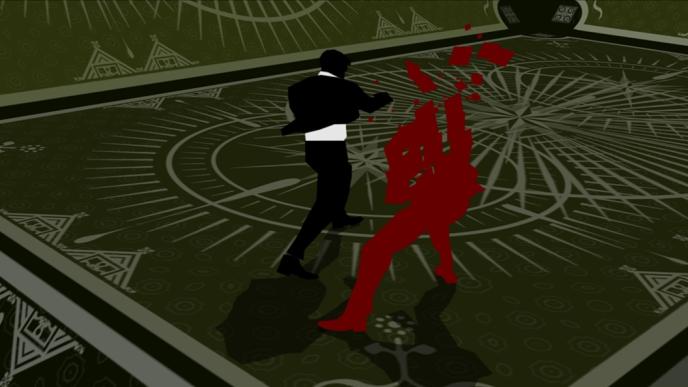
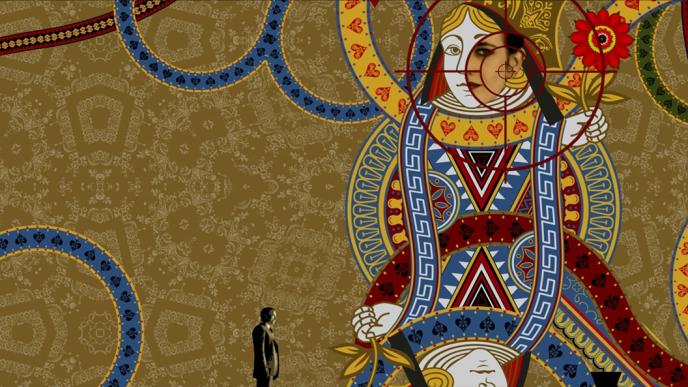
Contains Graphic Scenes
The film's title and subject matter were deciding factors in Kleinman's approach to the graphic elements. 'Martin Campbell (Casino Royale's director) mentioned that he liked the idea of a card motif and I took that and ran with it as far as possible', he recalls. 'One starting point was Ian Fleming's own design for the first edition of Casino Royale, which used the hearts from a playing card. I also remember that a puff of gun smoke stylised into the form of a club symbol came to me early, and I sketched that.'
Kleinman brought his ideas and sketches to William Bartlett, Head of Inferno at Framestore Commercials, and frequent Supervisor of Kleinman's commercials. The two had also worked together on three previous Bond title sequences. 'The previous film, Die Another Day (2002), was almost the apotheosis of the old style', says Bartlett, 'We'd taken it pretty much as far as it would go – the glossiness, the focus pulls, the fiery transitions – and I was delighted to be taking a new approach. Danny took the essences of the casino world - playing cards, roulette wheels, and the patterns on money itself - as his lead design elements.'
'We wanted to include fight sequences as part of the visuals, but we didn't want to wander into censorship territory with the violence. By using an animation-like technique – rotoscoping – over real footage of fights, we could create something that looked fantastic, but which also acted as a cushion or protective layer to the violence. Another reason we liked this so much was that we realised that you could have really quite crude – almost abstract - shapes that, because the movement was so real, were still intelligible.'
The look of the rotoscoped actors also tied in well with the work of another key influence on the titles – legendary designer Saul Bass. 'If you look at Bass's work on titles such as The Man With The Golden Arm or Vertigo', Bartlett elaborates, 'The shapes he used were pretty rudimentary – basically paper cut-outs. By applying computer technology to this basic material, we could create something that was simultaneously retro and ultra-modern.'
Special Delivery
Joining Bartlett in the Inferno suite was Framestore's Adam Parry, who both contributed ideas to the creative pool, and worked on their implementation. Bartlett and Parry would come up with suggestions and forward them to Kleinman, who would select ones he liked for further development.
Work was, naturally, cut to the film's title song, 'You Know My Name', by Chris Cornell. To avoid potential confusion rather than doing an edit in PAL and then converting it the whole thing was cut in Flame and the team worked at 24 frames throughout.
Initially, the Inferno team appeared to have, in Bartlett's words, a 'slightly luxurious deadline extension.' This was because, elsewhere in Framestore's Noel Street building, the company's Head of Digital Grading, Adam Glasman, was working with cinematographer Phil Meheux on the film's digital intermediate. This meant that transport and set-up issues to do with delivery of the completed titles would not be a problem. In the event, however, Bartlett was taken away from the titles for two weeks by another delivery deadline – the birth of his first child. He and Parry ended up working six weekends in a row, with 7.00am starts, in order to create the necessary time for the happy event. However, coming back from his paternity leave was, Bartlett says, 'a great chance to look at the details with a fresh eye.'

'Die Another Day', 2002
Die Another Day opened in the US and the UK on 22nd November 2002. The latest Bond extravaganza is directed by Lee Tamahori and produced by Barbara Broccoli and Michael G. Wilson.
In addition to contributing digital special effects and providing some stunning digital grading effects for the opening section of the film, Framestore has created Die Another Day’s title sequence. The title song is written and performed by Madonna.
New Paths Over Familiar Ground
Bond film title sequences have become legends in their own right, and this latest addition looks set to join its illustrious predecessors. Like any self-respecting addition, the Die Another Day titles bring a new twist of their own to the genre.
The sequence was designed and directed by Daniel Kleinman, working with one of Framestore’s Inferno wizards, William Bartlett.
The titles follow a tense and action-filled pre-title sequence, in which James Bond infiltrates an enemy camp, is captured, escapes and chases his captors to their deaths, and is finally recaptured. At this point Die Another Day takes the unprecedented step of continuing the story during the titles. It does this by showing us glimpses of Bond undergoing gruelling torture at the hands of his captors. This is seen in the background or otherwise filtered through the sensibility of the title sequence. On one levels the titles can be seen as a kind of dream sequence undergone by Bond as he endures his torture. We see the prisoner Bond’s face as it is thrust into an icy bath of water. Cue the music and titles.
The title sequence weaves together a number of features; some, like the dancing girls, are a familiar element common to all the Bond films that have gone before, others, such as the interplay of fiery, icy and electrical elements, are peculiar to Die Another Day.
This elemental interplay takes off from some of the standard tools in the torturer’s kit.
We see a red-hot poker transformed into a fiery finger, for example. Bond’s chief tormentor, the Scorpion Girl, uses the poisonous arachnids as tools of her trade, and they appear in the titles as CG creatures, created by Jake Mengers, Simon Stoney and Don M
Elements of Surprise
William Bartlett, who has worked with Kleinman on a number of previous projects, including earlier Bond titles and this year’s Xbox campaign, came up with a number of ideas for the director to play with. The ‘fire woman’ is a striking example of this. The model, Jackie, was shot at Pinewood under an ultra-violet light. Bartlett speaks admiringly of her professionalism and endurance during this shoot – nine hours wearing nothing but ultra-violet make-up, and no sitting down! The make-up provided a shadow-free, even skin texture. The skin was then treated through one of Inferno’s ‘sparks’, called ‘warp shrivel’, which squeezed the texture in and out. Four different versions of this were then painstakingly patched in over time intervals to create the illusion of movement over the skin’s surface. The result is a disturbingly 3D skin which bears more than a passing resemblance to molten lava.
Similar pains were taken over the ‘ice woman’ effect. The model was shot using two different cameras, and also scanned. The 3D team could then match and rotoscope her. The ice skin texture is a tricky one, as it can look jelly-like if not handled carefully. Bartlett added the appropriate fissures and cracks that ‘sell’ the idea of a living ice sculpture to the audience’s eye.
Throughout the title sequence we see images of Bond’s torture (which is taking place over several months) distorted through the fire and ice, solarised or refracted through diamond-like facets. Finally, as the sequence and song draw to a close, and director Lee Tamahori’s name appears, we get a last shot of the Scorpion Girl peering through the slit of Bond’s cell door. We return to the ‘real’ world of the film, some sixteen months has passed, and a bearded, haggard 007 is about to return to the fray…
The titles for Die Another Day are a daring and up-to-the-minute reworking of the Bond traditions. In addition, they demonstrate beautifully the enormous range of visual effects that the Inferno offers in the hands of the artists at Framestore.
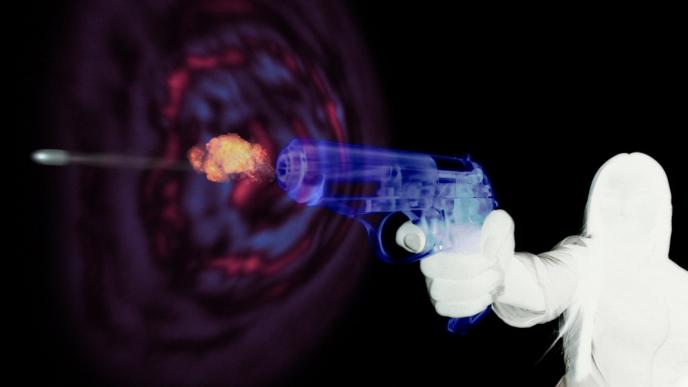
'Tomorrow Never Dies', 1997
Framestore assisted Limelight director Daniel Kleinman in producing the three minute opening titles of James Bond movie Tomorrow Never Dies. Reinforcing the film’s theme of unscrupulous world domination by a media mogul, the title sequence portrays the familiar Bond symbols of guns and gorgeous women, mixed with images of cyber-space, news footage and portrayed in numerous hi-tech, media related styles.
Among these differing visual styles are a variety of X-ray looks created using a combination of digital effects and perspex models. Pictures of x-ray guns were taken using airport security machines and assembled together in post production to produce strong graphic images of three dimensional gunscapes. A computer generated woman, made entirely out of electronic circuitry, was rotoscoped from live action for added realism. Even the classic silhouetted women were given a modern new look with digitally enhanced, semi-transparent clothing.
David Yardley and Tim Webber worked as a team helping the director to map out and design the sequence in Avid and Henry. It was then created at film resolution by Rob Duncan in Domino, with Avtar Bains in Inferno creating the smoky women and diamond necklace scenes. The cyber-space sequence was also created entirely in Inferno by William Bartlett. The CGI work was created on SoftImage by Framestore’s 3D department under the supervision of Mike Milne.
The title sequence took 8 weeks to complete and was world premiered in London on 9th December, 1997.
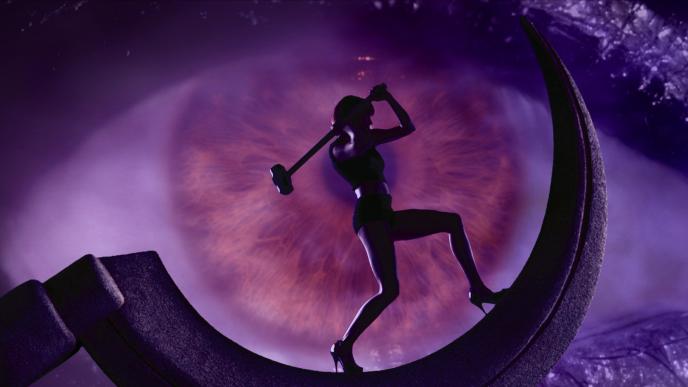
'GoldenEye', 1995
Based around the theme of the fall of communism, the GoldenEye titles are composed of an inventive mix of Russian symbols, guns, gorgeous women and of course, James Bond.
With live action elements scanned into Framestore's Domino film system, a three-minute sequence was first mocked up at video resolution to match pictures to the Tina Turner title track, giving Daniel Kleinman total control in creating a surreal world within a digital environment.
Supervised by Tim Webber, this video resolution assembly was then used as the basis of a five week digital film schedule, using a combination of Inferno and Domino compositing and effects film technology and 3D computer animation. This enabled the production of a continiuous piece (with virtually no cuts) to be completed electronically, before being recorded back onto film.
All stages of the post-production process (including scanning in and out of film, construction of a 3D gun barrel, bullet and tex artwork) were controlled in-house at Framestore.
